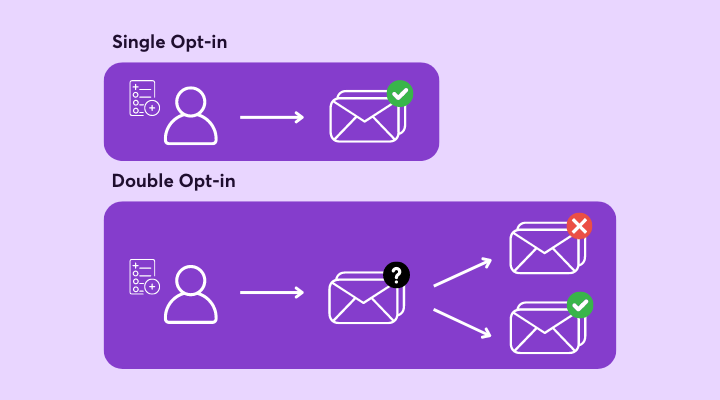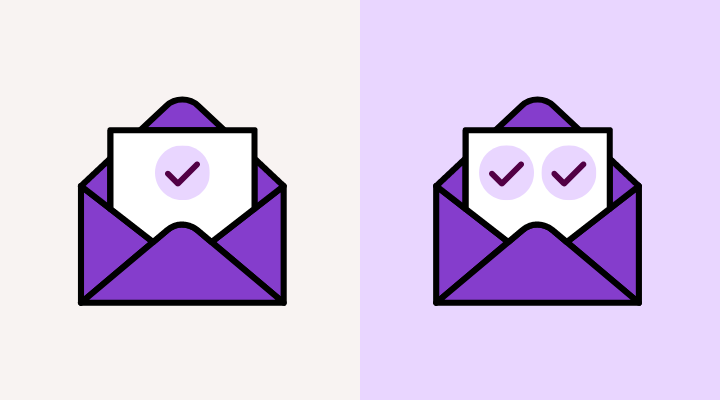The way you collect your contacts – whether through single opt-in or double opt-in – can impact the quality of your list, the engagement rates with your campaigns, and even your message deliverability.
Each method has its own advantages and disadvantages, and choosing the right one for you primarily depends on your business goals and the audience you want to reach.
In this article, we will examine the differences between single and double opt-in and which one is more suitable for your business communication.
Overview
- What is Single Opt-In?
- Advantages of Single Opt-In
- Disadvantages of Single Opt-In
- What is Double Opt-In?
- Advantages of Double Opt-In
- Disadvantages of Double Opt-In
- Differences between Single and Double Opt-In
- Which one to choose based on your needs
What is Single Opt-In?
Single opt-in is a simple method for collecting contact information. Once someone fills in your sign-up form, they are immediately added to your contact list without any further confirmation. This means that as soon as a potential subscriber submits their details, they can start receiving your messages.
Advantages of Single Opt-In
- Faster list growth: The absence of additional steps allows for immediate subscriber additions, ideal if you want to grow your list quickly.
- Simple registration process: Subscribers don’t need to confirm their details, which reduces the chance of them abandoning the registration process, leading to higher sign-up rates.
- Immediate communication: You can start sending messages right after the sign-up, keeping new subscribers engaged while they are still interacting with your brand.
Disadvantages of Single Opt-In
- Lower subscriber quality: Single opt-in can lead to a lower-quality list, as some subscribers may enter incorrect or invalid details. This can negatively affect your open rates and campaign engagement.
- More spam: Without the extra confirmation step, there is a risk of spam traps or malicious registrations being added to your list, increasing the chance of your communications being marked as spam.
What is Double Opt-In?
Double opt-in adds an extra confirmation step to the registration process. After the user enters their details in the sign-up form, they receive an email with a confirmation link. Once they click this link, they are officially added to your contact list.
Advantages of Double Opt-In
- Better list quality: Since subscribers must confirm their registration, double opt-in ensures that users are genuinely interested in your content. This often leads to higher engagement rates!
- Optimal message deliverability: Double opt-in reduces the likelihood of invalid contact details being added to your list, helping maintain a “clean” list and maximizing your message deliverability.
Disadvantages of Double Opt-In
- Slower list growth: Double opt-in can slow down your list growth since some users may forget or fail to complete the confirmation step.
- More complex registration process: The extra step can discourage some users, which can be an issue if your campaigns are focused on immediate actions, like limited-time offers.
Differences between Single and Double Opt-In

- List growth speed: Single opt-in allows for faster list growth as subscribers are added right after sign-up. In contrast, with double opt-in, users must confirm their registration first, adding an extra step.
- Data quality: Double opt-in leads to a higher-quality list, as confirmed subscribers are more likely to engage with your content. With single opt-in, you may end up with a larger but less active list.
- Security: Double opt-in offers more security in terms of spam complaints and malicious sign-ups, while also helping to better comply with data protection regulations. Single opt-in, though faster, carries a greater risk of unwanted or malicious registrations.
Which method is right for you?
The choice between single and double opt-in depends primarily on your goals and the quality level you want for your subscribers.
When to choose Single Opt-In:
- Focus on list growth: If your goal is to rapidly grow your email list, especially in cases like product launches or limited-time offers, single opt-in is the right choice.
- You have email verification systems: If you use tools to verify and clean your list, single opt-in can work without negatively impacting quality.
When to choose Double Opt-In:
- Quality over quantity: If you want a list of subscribers who are truly interested in your content, double opt-in is the better option, as it ensures the registration of active and engaged users.
- Deliverability and reliability: If email deliverability is a priority for your business, then double opt-in is the ideal solution. This method ensures your list stays clean, minimizing the risk of delivery issues, spam complaints, and a decline in your sender reputation.
Learn more and implement the double opt-in method in your Apifon account.
Both single and double opt-in have their own benefits, but your choice should align with your business needs and goals.
Start now with Apifon and enjoy specialized features and tools that will help you manage your subscriber list in the most efficient way.

